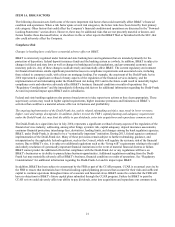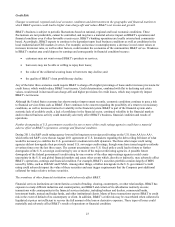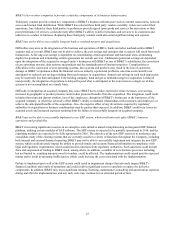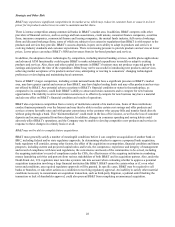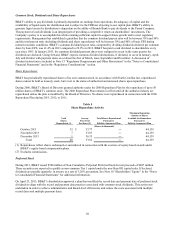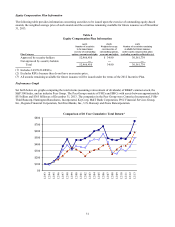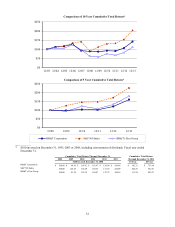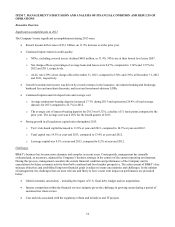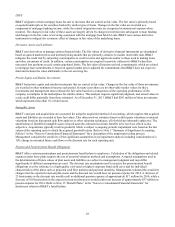BB&T 2013 Annual Report Download - page 28
Download and view the complete annual report
Please find page 28 of the 2013 BB&T annual report below. You can navigate through the pages in the report by either clicking on the pages listed below, or by using the keyword search tool below to find specific information within the annual report.28
Strategic and Other Risk
BB&T may experience significant competition in its market area, which may reduce its customer base or cause it to lower
prices for its products and services in order to maintain market share.
There is intense competition among commercial banks in BB&T’s market area. In addition, BB&T competes with other
providers of financial services, such as savings and loan associations, credit unions, consumer finance companies, securities
firms, insurance companies, commercial finance and leasing companies, the mutual funds industry, full-service brokerage
firms and discount brokerage firms, some of which are subject to less extensive regulations than BB&T is with respect to the
products and services they provide. BB&T’s success depends, in part, on its ability to adapt its products and services to
evolving industry standards and customer expectations. There is increasing pressure to provide products and services at lower
prices. Lower prices can reduce BB&T’s NIM and revenues from its fee-based products and services.
In addition, the adoption of new technologies by competitors, including internet banking services, mobile phone applications
and advanced ATM functionality could require BB&T to make substantial expenditures to modify or adapt its existing
products and services. Also, these and other capital investments in BB&T’s business may not produce expected growth in
earnings anticipated at the time of the expenditure. BB&T may not be successful in introducing new products and services,
achieving market acceptance of its products and services, anticipating or reacting to consumers’ changing technological
preferences or developing and maintaining loyal customers.
Some of BB&T’s larger competitors, including certain national banks that have a significant presence in BB&T’s market
area, may have greater capital and resources than BB&T, may have higher lending limits and may offer products and services
not offered by BB&T. Any potential adverse reactions to BB&T’s financial condition or status in the marketplace, as
compared to its competitors, could limit BB&T’s ability to attract and retain customers and to compete for new business
opportunities. The inability to attract and retain customers or to effectively compete for new business may have a material
and adverse effect on BB&T’s financial condition and results of operations.
BB&T also experiences competition from a variety of institutions outside of its market area. Some of these institutions
conduct business primarily over the Internet and may thus be able to realize certain cost savings and offer products and
services at more favorable rates and with greater convenience to the customer who can pay bills and transfer funds directly
without going through a bank. This “disintermediation” could result in the loss of fee income, as well as the loss of customer
deposits and income generated from those deposits. In addition, changes in consumer spending and saving habits could
adversely affect BB&T’s operations, and the Company may be unable to develop competitive new products and services in
response to these changes on a timely basis or at all.
BB&T may not be able to complete future acquisitions.
BB&T must generally satisfy a number of meaningful conditions before it can complete an acquisition of another bank or
BHC, including federal and/or state regulatory approvals. In determining whether to approve a proposed bank acquisition,
bank regulators will consider, among other factors, the effect of the acquisition on competition, financial condition and future
prospects, including current and projected capital ratios and levels, the competence, experience and integrity of management
and record of compliance with laws and regulations, the convenience and needs of the communities to be served, including
the acquiring institution’s record of compliance under the CRA, the effectiveness of the acquiring institution in combating
money laundering activities and protests from various stakeholders of both BB&T and its acquisition partner. Also, under the
Dodd-Frank Act, U.S. regulators must now take systemic risk into account when evaluating whether to approve a potential
acquisition transaction involving a large financial institution like BB&T. BB&T cannot be certain when or if, or on what
terms and conditions, any required regulatory approvals will be granted. In specific cases, BB&T may be required to sell
banks or branches, or take other actions as a condition to receiving regulatory approval. An inability to satisfy other material
conditions necessary to consummate an acquisition transaction, such as third-party litigation, a judicial order blocking the
transaction or lack of shareholder approval, could also prevent BB&T from completing an announced acquisition.





